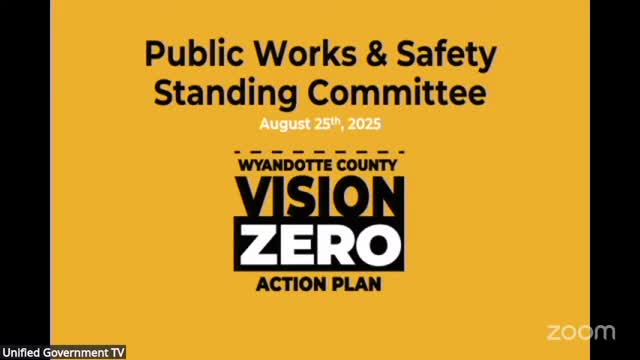Vision Zero update: county plans targets, crash map and draft mission ahead of action item
August 25, 2025 | Wyandotte County, Kansas
This article was created by AI summarizing key points discussed. AI makes mistakes, so for full details and context, please refer to the video of the full meeting. Please report any errors so we can fix them. Report an error »

County staff and consultants briefed a standing committee on progress for the Safe Streets for All Vision Zero action plan, sharing public-engagement results, crash analysis and draft vision and mission statements the steering committee had developed.
Anthony Gallo of Kimley‑Horn, the consultant on the plan, said the effort is funded by a $1,200,000 award from federal and KDOT sources and is a partnership between the Unified Government and the partner cities of Bonner Springs, Edwardsville and Lake Quivira. "We're using crash report data, both local and state level to identify the biggest transportation safety issues in the county," Gallo said, and noted the work aims to identify targeted infrastructure projects and updates to internal policies.
Gallo summarized the crash analysis: "approximately 40,000 crashes over the past 10 years, 10,000 involving a possible injury or worse, and just over a thousand a year, that are fatal or disabling injury crashes... about a 100 crashes per year that involve a fatality or a disabling injury." He said the team found roughly 50 crashes a year over the past decade that involved pedestrians or bicyclists.
Public engagement: The project collected more than 500 online comments. Common themes included lack of sidewalks, unclear crosswalks, visibility obstructions, confusing controls and speeding, especially in residential and school zones. Staff described ongoing in‑person outreach at community events, school back‑to‑school fairs and plans to engage high‑school students next year.
Draft vision, mission and goals: The steering committee drafted a vision to "eliminate fatalities and serious injuries on roads in the county by 2050" and a mission committing the Unified Government and partner cities to "adopting data driven policies that prioritize human life and safety." Draft goals focus on vulnerable users, school access, public education, interagency collaboration and designing roads to prioritize safety over speed.
Questions and next steps: Committee members asked how traffic calming and speed humps are implemented and whether the plan could address arterial speeding without impeding traffic flow. Chris Finger, City Traffic Engineer, described a petition process for neighborhood speed humps and said the department avoids speed humps on major arterials, adding it may use consultants for data collection on collectors and arterials. Staff said they plan to return next month with an action item asking the committee to approve the vision and goals and then seek full commission adoption in October.
Ending: The committee received the update for information only and asked staff to return with a formal action item and additional details on prioritized project locations and policy changes.
Anthony Gallo of Kimley‑Horn, the consultant on the plan, said the effort is funded by a $1,200,000 award from federal and KDOT sources and is a partnership between the Unified Government and the partner cities of Bonner Springs, Edwardsville and Lake Quivira. "We're using crash report data, both local and state level to identify the biggest transportation safety issues in the county," Gallo said, and noted the work aims to identify targeted infrastructure projects and updates to internal policies.
Gallo summarized the crash analysis: "approximately 40,000 crashes over the past 10 years, 10,000 involving a possible injury or worse, and just over a thousand a year, that are fatal or disabling injury crashes... about a 100 crashes per year that involve a fatality or a disabling injury." He said the team found roughly 50 crashes a year over the past decade that involved pedestrians or bicyclists.
Public engagement: The project collected more than 500 online comments. Common themes included lack of sidewalks, unclear crosswalks, visibility obstructions, confusing controls and speeding, especially in residential and school zones. Staff described ongoing in‑person outreach at community events, school back‑to‑school fairs and plans to engage high‑school students next year.
Draft vision, mission and goals: The steering committee drafted a vision to "eliminate fatalities and serious injuries on roads in the county by 2050" and a mission committing the Unified Government and partner cities to "adopting data driven policies that prioritize human life and safety." Draft goals focus on vulnerable users, school access, public education, interagency collaboration and designing roads to prioritize safety over speed.
Questions and next steps: Committee members asked how traffic calming and speed humps are implemented and whether the plan could address arterial speeding without impeding traffic flow. Chris Finger, City Traffic Engineer, described a petition process for neighborhood speed humps and said the department avoids speed humps on major arterials, adding it may use consultants for data collection on collectors and arterials. Staff said they plan to return next month with an action item asking the committee to approve the vision and goals and then seek full commission adoption in October.
Ending: The committee received the update for information only and asked staff to return with a formal action item and additional details on prioritized project locations and policy changes.
View full meeting
This article is based on a recent meeting—watch the full video and explore the complete transcript for deeper insights into the discussion.
View full meeting
